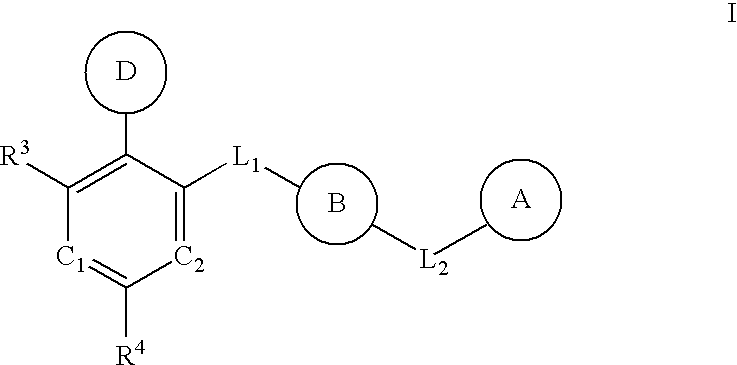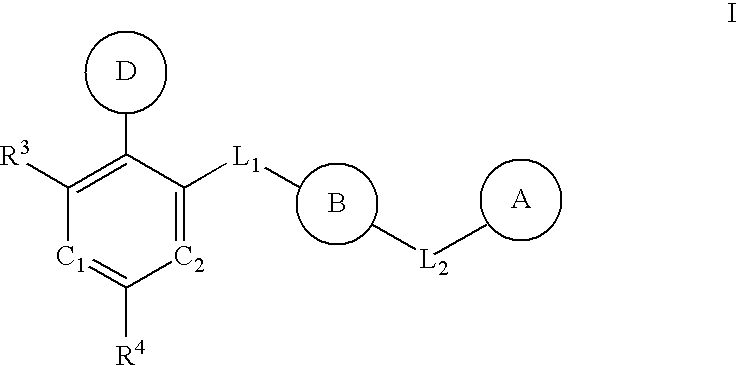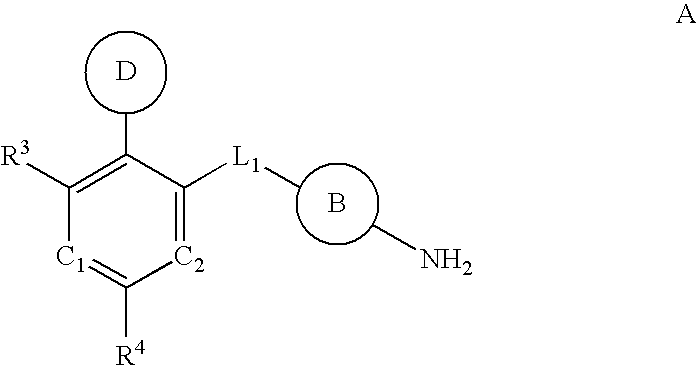Multi-cyclic compounds and method of use
a multi-cyclic compound and compound technology, applied in the field of multi-cyclic compounds, can solve the problems of endothelial death, loss of vascular structure and matrix contacts, and less favorable anti-angiogenic therapeutic approaches, and achieve the effects of reducing the risk of angiogenic diseas
- Summary
- Abstract
- Description
- Claims
- Application Information
AI Technical Summary
Benefits of technology
Problems solved by technology
Method used
Image
Examples
example 1
Synthesis of 4-(1-methyl-4-phenyl-1H-imidazol-2-ylamino)phenol
Step 1: 1-methyl-4-phenyl-1H-imidazole
[0296]To a slurry of sodium hydride, 60% in mineral oil (1.2 g, 31 mmol) in 100 mL anhyd. THF at 0° C. was added 4-phenylimidazole (4.00 g, 28 mmol) in small portions under nitrogen. Upon complete addition, the reaction was homogeneous and orange. After 10 min, methyl iodide (2.1 ml, 33 mmol) was added and the reaction was allowed to warm to ambient temperature. After 2 h, the reaction was quenched with 10 mL water and concentrated in vacuo. The resulting liquid was partitioned between water / brine and DCM. The aqueous layer was extracted with DCM (4×). The combined organic extracts were dried over anhyd sodium sulfate, filtered, and concentrated in vacuo to give an orange solid. This was dissolved in dichloromethane and purified by silica gel chromatography, 120 g, 60 min, 0-50% 90 / 10 DCM / MeOH in DCM, to give 1-methyl-4-phenyl-1H-imidazole and 1-methyl-5-phenyl-1H-imidazole as off-whi...
example 2
Synthesis of N1-(2-(dimethylamino)ethyl)benzene-1,2-diamine
Step 1: N-(2-(dimethylamino)ethyl)-2-nitrobenzenamine
[0299]To a mixture of 2-fluoronitrobenzene (2.0 g, 14 mmol) and sodium bicarbonate (5.9 g, 71 mmol) in 30 mL THF under nitrogen was added N1, N1-dimethylethane-1,2-diamine (1.7 mL, 16 mmol). The reaction was allowed to stir at ambient temperature for 3 h, and then a water-cooled reflux condenser was added and the mixture was heated to 70° C. for 16 h. The reaction was cooled to ambient temperature, filtered through paper, and concentrated in vacuo to give N-(2-(dimethylamino)ethyl)-2-nitrobenzenamine as a yellow oil. This material was used without further purification.
Step 2: N1-(2-(dimethylamino)ethyl)benzene-1,2-diamine
[0300]N-(2-(dimethylamino)ethyl)-2-nitrobenzenamine (2.0 g, 14 mmol) and 10% palladium on carbon, wet, 50% water (3.0 g) were combined under nitrogen. 30 mL MeOH was added via syringe, and the atmosphere was replaced with hydrogen from a balloon. The react...
example 3
Synthesis of N1-(3-(dimethylamino)propyl)benzene-1,2-diamine
[0301]The title compound was synthesized in a manner analogous to that described in Example 2. MS m / z=194 [M+H]+. Calc'd for C11H19N3: 193.3.
PUM
| Property | Measurement | Unit |
|---|---|---|
| temperatures | aaaaa | aaaaa |
| temperatures | aaaaa | aaaaa |
| flow rate | aaaaa | aaaaa |
Abstract
Description
Claims
Application Information
 Login to View More
Login to View More - R&D
- Intellectual Property
- Life Sciences
- Materials
- Tech Scout
- Unparalleled Data Quality
- Higher Quality Content
- 60% Fewer Hallucinations
Browse by: Latest US Patents, China's latest patents, Technical Efficacy Thesaurus, Application Domain, Technology Topic, Popular Technical Reports.
© 2025 PatSnap. All rights reserved.Legal|Privacy policy|Modern Slavery Act Transparency Statement|Sitemap|About US| Contact US: help@patsnap.com



